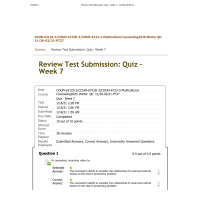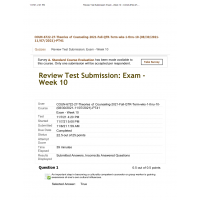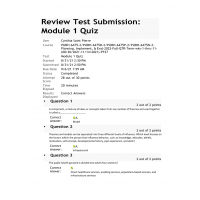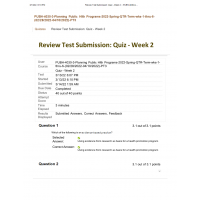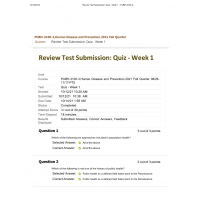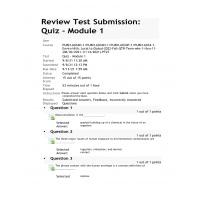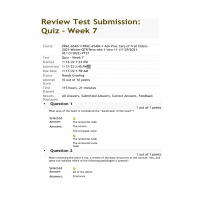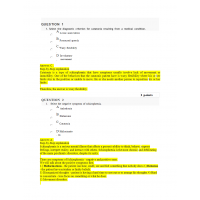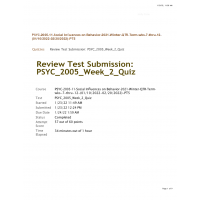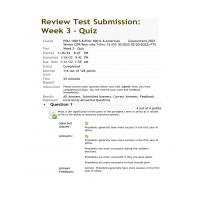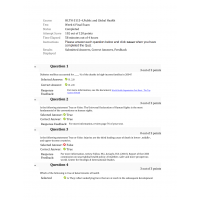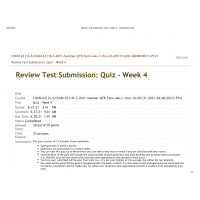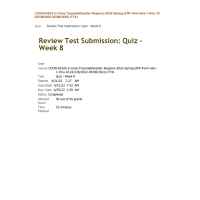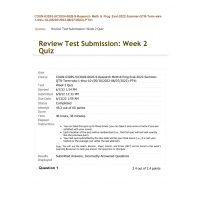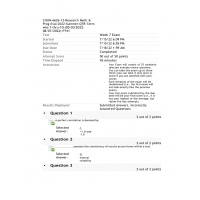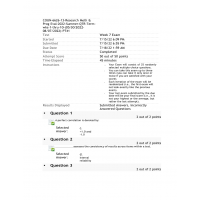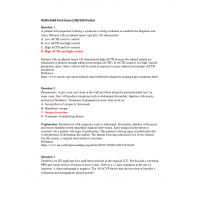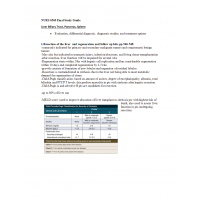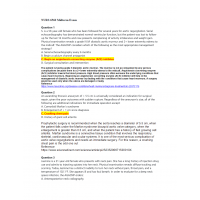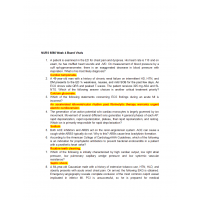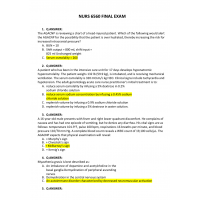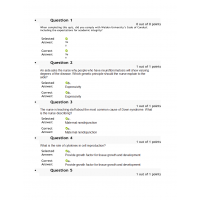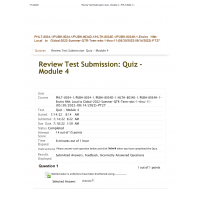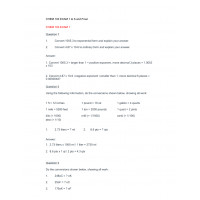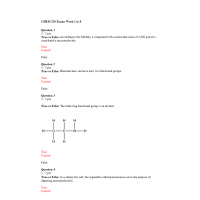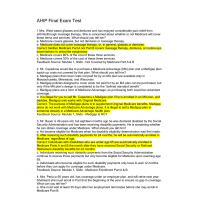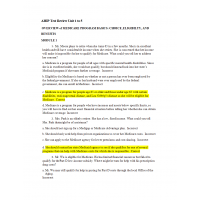TNCC final exam test 2022 open book
1. Why is a measure of serum lactate obtained in the initial assessment of the trauma patient?
2. A trauma patient is restless and repeatedly asking "where am I?" vital signs upon arrival were BP 100/60 mm Hg, HR 96 beats/min, and RR 24 breaths/min. Her skin is cool and dry. Current vital signs are BP 104/84mm Hg, HR 108, RR 28 breaths/min. The patient is demonstrating signs and symptoms of which stage of shock?
3. An elderly patient with a history of anticoagulant use presents after a fall at home that day. she denies any loss of consciousness. She has a hematoma to her forehead and complains of headache, dizziness, and nausea. Which is a most likely cause of her symptoms?
4. EMS brings a patient who fell riding his bicycle. Using the American College of Surgeons screening guidelines, which assessment finding would prompt the nurse to prepare the patient for radiologic spine clearance?
5. Which of the following occurs during the third impact of a motor vehicle crash?
6. A passenger is brought to the emergency department of a rural hospital following a high-speed MVC. When significant abdominal and pelvic injuries are noted in the primary survey, which of the following is the priority interventions?
7. Which of the following injuries is LEAST likely to be promptly identified?
8. Patients with a crush injury should be monitored for which of the following conditions?
9. What finding raises suspicion of complete spinal cord injury?
10. A patient with a complete spinal cord injury in neurogenic shock will demonstrate hypotension and which other clinical signs?
11. A 5-year old child presents to the ED with bruises to the upper arms and buttocks in various stages of healing and multiple small, clean, round burns to the back. There are no abnormalities found based on the pediatric assessment triangle or primary survey. Which of the following is the priority nursing intervention?
12. A patient with lower extremity fracture complains of severe pain and tightness in his calf, minimally relieved by pain medications. Which of the following is the priority nursing intervention?
13. A 36-year old female has a deformity of the left wrist after a fall. She is reluctant to move her hand due to pain. Which of the following is the most appropriate intervention?
14. Which of the following is a late sign of increased intracranial pressure?
15. Which of the following mnemonics can help the nurse prioritize care for a trauma patient with massive uncontrolled hemorrhage?
16. A patient is thrown against a car during a tornado and presents with obvious bilateral femoral fractures. The patient is pale, alert, disoriented, and has delayed cap refill. Which of the following interventions would be most appropriate for this patient based on the disaster triage principle?
17. A patient arrives with a large open chest wound after being assault ed with a machete, Prehospital providers placed a nonporous dressing over the chest wound and tapes it on 3 sides. He is now showing signs of anxiety, restlessness, severe respiratory distress, cyanosis, and decreasing blood pressure. Which of the following is the MOST appropriate interventions?
18. A patient is found lying on the floor after falling 13 hours ago. Which of the following lab values is expected with a musculoskeletal complication associated with this presentation?
19. A 56-year- male patient involved in a MVC is brought to the ED of a rural critical access facility. He c/o neck pain, SOB, and diffuse abd pain. His GCS is 15. His vitals are as follows:
20. Which of the following is the priority intervention for thispatient?
21. Caregivers carry a 2-year old into the ED who fell out of 2nd story window. The patient is awake and crying with increased work of breathing and pale skin. which of the following interventions has the highest priority?
22. Which of the following is a component of the trauma triad of death?
23. A 35-year old male presents with facial trauma after bring struck inthe face with a baseball. a tear-drop shaped left pupil is noted on exam. What type of injury is suspected?
24. Which of the following is true about the log roll maneuver?
25. EMS arrives with the intoxicated driver of a car involved in a MVC. EMS reports significant damage to the drivers side of the car. The patient is asking to have the cervical color removed. when is it appropriate to remove the cervical collar?
26. Tearing of the bridging veins is most frequently associated with which brain injury?
27. If a patient has received multiple transfusions of banked blood preserved with citrate, which electrolyte is most likely to drop and require supplementation?
28. A trauma patient is en route to a rural ED. Radiology notifies the charge nurse that the CT scanner will be out of service for several of hours. The team gathers to plan accordingly. Which of the following terms best describes this trauma teams communication?
29. The nurse is caring for a 120 kg male is brought in after a warehouse fire and is calculating the patient's fluid resuscitation needs. He has painful red blistering to the entire surface of both upper extremities and superficial burns to the anterior chest. Using the modified Lund and Browder chart to calculate the total BSA burned, how much IV fluids would be administered in the first 8 hours?
30. Which of the following assessment findings differentiates a tension PTX from a simple PTX?
32. Which of the following considerations is most important when caring for a geriatric trauma patient?
33. An intubated trauma patient is being transferred to a tertiary care center. After moving the patient to the stretcher for transport, a drop in pulse oximetry to 85% is noted. Which of the following is the priority interventions?
34. What factor contributes most the kinetic energy of a body in motion?
35. During the primary survey of an unconscious patient with multi- system trauma, the nurse notes snoring respirations. Which priority nursing interventions should be performed next?
36. Following a review of recent drills and a real disaster event, a hospital has identified deficiencies and is taking steps to minimize the impact of future disaster. Which phase of the disaster life cycle does this describe?
37. Which pulse pressure description is an indication of early hypovolemic shock?
38. The most reassuring finding for a male patient with hop pain after a fall is which of the following?
39. A 49-year old restrained driver involved in a MVC presents to the trauma center c/o abd, pelvic, and bil lower extremity pain Vitals signs are stable. The nurse can anticipate all of these negative fast exam except which of the following?
40. The FAST exam is done at the bedside to identify pathological fluid in the abdominal and pelvic cavities. FAST exams reduce the use of more invasive diagnostic peritoneal lavage and can be repeated if clinical changes or hemodynamic changes occur. A negative FAST study does not rule out injury and may warrant a follow-up computed tomography scan. Serial FAST exams can identify increasing abdominal fluid collections from hemorrhage. Diagnostic peritoneal lavage/diagnostic peritoneal aspiration is performed by the surgical team to rapidly identify the presence of hemorrhage in patients who are hemodynamically unstable after trauma.
41. Which of the following is an expected finding in a patient with a thoracostomy connected to a chest drainage system?
42. Which of the following patients warrants referral to a burn center?
43. A patient has been in the ED for several hours waiting to be admitted. He sustained multiple rib fractures and a femur fracture after a fall. He has been awake, alert, and c/o leg pain. His wife reported suddenly becoming anxious and confused. Upon reassessment, the patient is restless, with respiratory distress and petechiae to his neck. the patient is exhibiting signs of symptoms commonly associated with which of the following conditions?
44. Which is the effect of hypothermia on the oxyhemoglobin dissociation curve?
45. A 20-year old male presents to the ED c/o severe lower abd pain after landing hard on the bicycle cross bars which performing an aerial BMX maneuver. Secondary assessment reveals lower abd tenderness and scrotal ecchymosis. Which of the following orders would the nurse questions?
46. You are treating a 27-year old male in respiratory distress who was involved in a house fire. Calculating TBSA burned is deferred d/t the need for emergent intubation. At what rate should you begin fluid resuscitation?
47. Which of the following is possible complication of positive-pressure ventilation?
48. Which of the following is NOT considered goal-directed therapy of cardiogenic shock?
49. What bedside monitoring parameters are used to assess for adequacy of oxygenation and effectiveness of ventilation?
50. Which if the following values indicates the need for alcohol withdrawal interventions?
51. An unresponsive trauma patient has an oropharyngeal airway in place, shallow and labored respiratory, and dusky skin. the trauma team has administered medications for drug assisted intubation and attempted intubation but was unsuccessful. What is the most appropriate immediate next step?
52. The trauma nurse knows that placing a bariatric patients in a "ramped position" provides better visualization during the insertion of which device?
53. You are caring for a patient who was involved in a MVA and is 32 weeks pregnant. Findings of your secondary survey include abd pain on palpation, fundal high at the costal margin, and some dark bloody show. Varying, accelerations and decelerations are noted on the cardiotocography. These findings are most consistent with which of the following?
| Institution & Term/Date | |
| Term/Date | Walden University |
TNCC Final Exam Test 2022 Open Book
- Product Code: 2022
- Availability: In Stock
-
$30.00
Related Products
COUN 6312S Week 7 Quiz
$14.99
PUBH-4030-3 Week 2
$9.99
NURS 6635 Final Exam 2021
$35.00
POLI-1001S-6 Week 3 Quiz
$12.00
HLTH 3115 Final Exam
$25.00
NURS 6560 Final Exam 1
$40.00
NURS 6560 Midterm Exam
$30.00
AHIP Test Review Unit 1 to 5
$45.00


